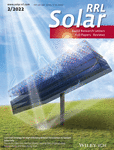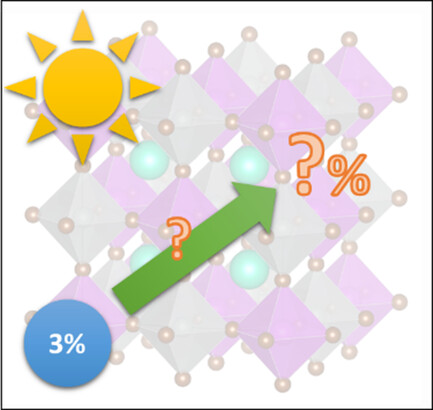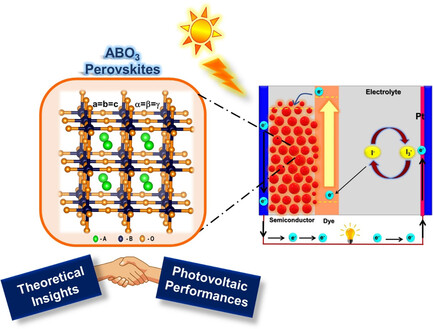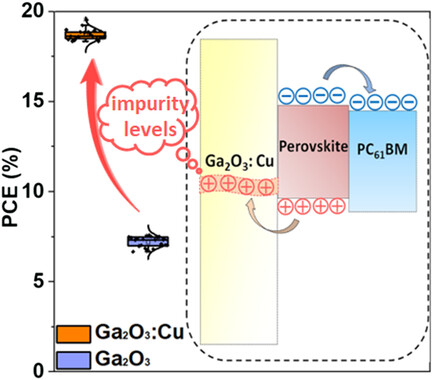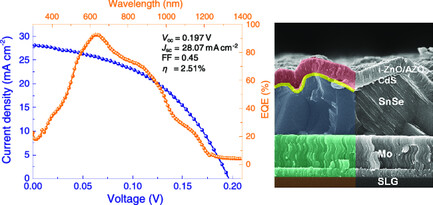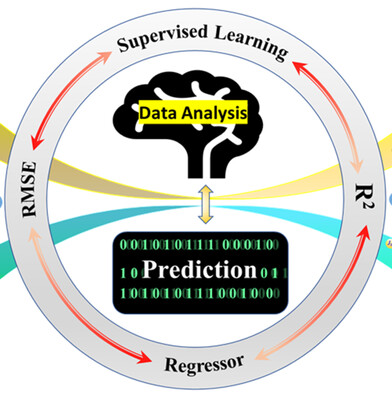Journal list menu
Export Citations
Download PDFs
Cover Picture
Low-Cost Strategy for High-Efficiency Bifacial Perovskite/c-Si Tandem Solar Cells
- First Published: 08 February 2022
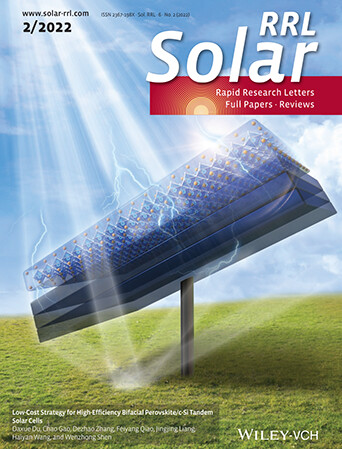
Tandem Solar Cells
In article number 2100781, Wenzhong Shen and co-workers have proposed and proven that bifacial perovskite/c-Si tandem solar cells can not only improve the energy output, but also significantly reduce the Si thickness while maintaining the high efficiency. The photovoltaic performance of bifacial perovskite/c-Si tandem solar cells combining existing large-scale preparation technologies, was also optimized.
Inside Front Cover
Hierarchically Porous Polymeric Carbon Nitride as a Volume Photocatalyst for Efficient H2 Generation under Strong Irradiation
- First Published: 08 February 2022

Volume Photocatalysis
In article number 2100823, Yuexiang Li and co-workers found that tube-like polymeric carbon nitride with wall nanopores which was prepared by pyrolyzing needle-like urea, shows enhanced photoabsorption under strong irradiation, and allows the reactant formic acid to effectively insert into its volume/interlayers. Different from conventional surface photocatalysis, the reaction efficiency of the volume photocatalysis rises with irradiation intensity.
Back Cover
Solid-State Ligand-Capped Metal Oxide Electron-Transporting Layer for Efficient and Stable Fullerene-Free Perovskite Solar Cells
- First Published: 08 February 2022
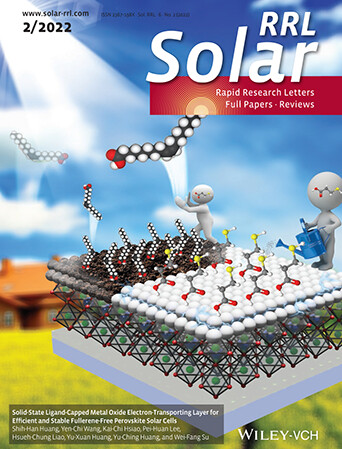
Perovskite Solar Cells
In article number 2100671, Yu-Ching Huang and co-workers developed a process for fabricating perovskite solar cells with all-oxide charge transporting layers under ambient condition. By using solid-state ligand exchange at room temperature, the more conductive Ta-doped SnO2 could be applied to manufacture perovskite solar cells with excellent operation stability.
Masthead
Perspectives
Cs2AgBiBr6 Double Perovskites as Lead-Free Alternatives for Perovskite Solar Cells?
- First Published: 23 November 2021
Metal Chalcohalides: Next Generation Photovoltaic Materials?
- First Published: 01 December 2021
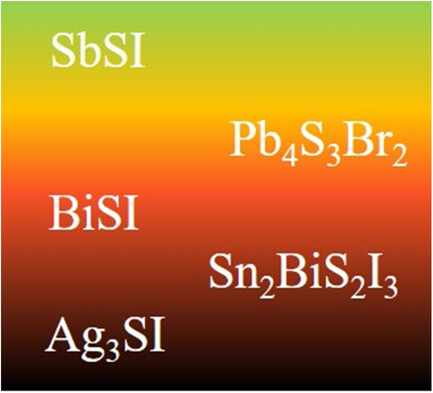
This Perspective highlights a wide variety of metal chalcohalide semiconductors relevant for photovoltaic applications. These rather overlooked materials present a high degree of bandgap tunability which makes them suitable as single-junction solar cell absorbers as well as low- or wide-bandgap light-harvesting materials in multijunction configurations. Furthermore, many metal chalcohalides are based on relatively abundant and low-toxicity elements.
Reviews
Effect of Third Component on Efficiency and Stability in Ternary Organic Solar Cells: More than a Simple Superposition
- First Published: 17 November 2021

Ternary organic solar cells (OSCs) are high-performance solar cells based on photovoltaic technologies that have emerged as potential energy technologies. The active layers of ternary OSCs comprise donor/acceptor host components and a third component. This review categorizes and describes the effects that the role and function of the third component have on the efficiency and stability of ternary OSCs.
MXenes—An Emerging Class of 2D Materials for Solar Water Desalination: Feasibility and Recent Advances
- First Published: 22 November 2021
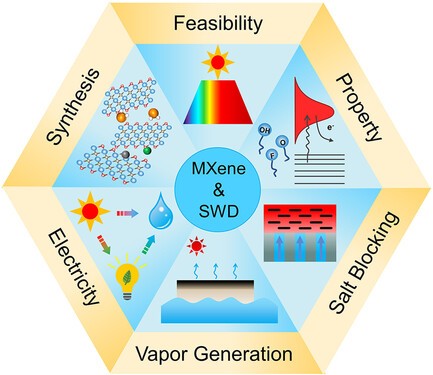
The past decade has witnessed the rapid growth of 2D MXenes; they have shown flexible optical properties, strong localized surface plasmon resonance mechanism, and special response to light in solar water desalination. Herein, the main strategies for constructing MXenes-based photothermal evaporators for efficient desalination are highlighted. The key challenges are also discussed and future directions of this hot topic are outlined.
Account of Structural, Theoretical, and Photovoltaic Properties of ABO3 Oxide Perovskites Photoanode-Based Dye-Sensitized Solar Cells
- First Published: 17 December 2021
Research Articles
Low-Cost Strategy for High-Efficiency Bifacial Perovskite/c-Si Tandem Solar Cells
- First Published: 05 November 2021
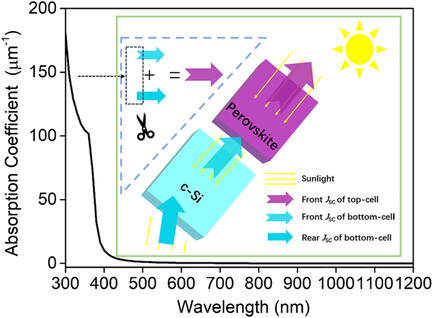
A quite thick c-Si bottom-cell has to be used to fully absorb near-infrared photons, which greatly improves the cost of the perovskite/c-Si tandem solar cells (TSCs). The bifacial two-terminal TSCs can not only improve the energy output, but also significantly reduce the Si thickness while maintaining high efficiency.
Hierarchically Porous Polymeric Carbon Nitride as a Volume Photocatalyst for Efficient H2 Generation under Strong Irradiation
- First Published: 09 November 2021
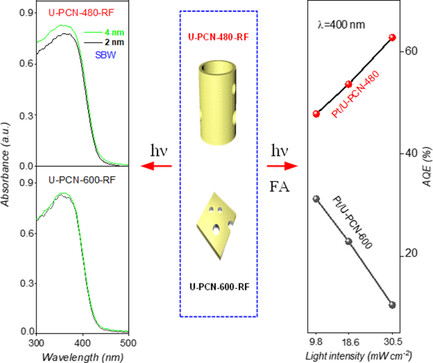
Hierarchically porous U-PCN-480 prepared by template-free pyrolysis of urea is a volume photocatalyst (VPt). Its porous structure enhances the photoabsorption under strong irradiation. The VPt displays excellent volume photocatalysis (VPs) activity for hydrogen evolution in the formic acid reaction system. Notably, the reaction efficiency increases with increasing irradiation intensity due to the synergy between VPs and the enhanced photoabsorption.
Solid-State Ligand-Capped Metal Oxide Electron-Transporting Layer for Efficient and Stable Fullerene-Free Perovskite Solar Cells
- First Published: 07 December 2021

A room temperature solid-state ligand exchange method modified tantalum-doped tin oxide (Ta-SnO2) with a functional ligand, enhancing the conductivity of Ta-SnO2 and improving the band alignment with the electrode is reported. Furthermore, the efficiency of fullerene-free devices can achieve up to 15.48%. All-oxide devices can maintain 80% performance after 1000 and 540 h under damp heat and light soaking tests.
Are Perovskite Solar Cell Potential-Induced Degradation Proof?
- First Published: 11 December 2021
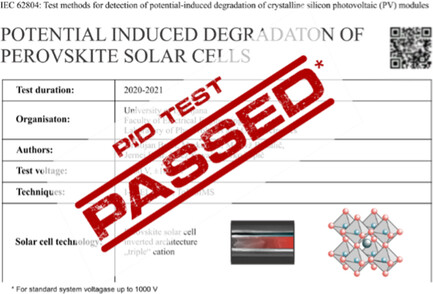
The resistance of perovskite solar cells (PSC) to potential induced degradation (PID) is investigated by the help of I–V curve, electroluminescence, external quantum efficiency measurements, and secondary ion mass spectrometry. The PSCs are PID proof when they are exposed to current system voltages but degrade very fast if they are exposed to a high voltage of −1000 V.
Phenyl Extended Naphthalene-Based Covalent Triazine Frameworks as Versatile Metal-Free Heterogeneous Photocatalysts
- First Published: 09 December 2021
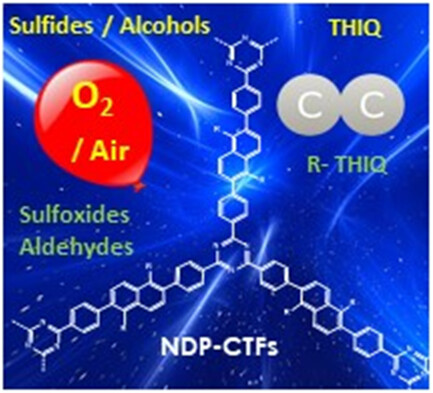
Phenyl extended naphthalene-based-covalent triazine frameworks (PhN-CTFs) result in effective heterogeneous photocatalysts for the metal-free selective aerobic oxidation of sulfides to sulfoxides and the cross-dehydrogenative C—C coupling reaction under visible-blue light irradiation. The PhN-CTFs also exhibited good substrates applicability for both reactions as well as excellent chemical stability.
High Vapor Transport Deposition: A Novel Process to Develop Cu2ZnSn(SxSe1–x)4 Thin Film Solar Cells
- First Published: 07 December 2021
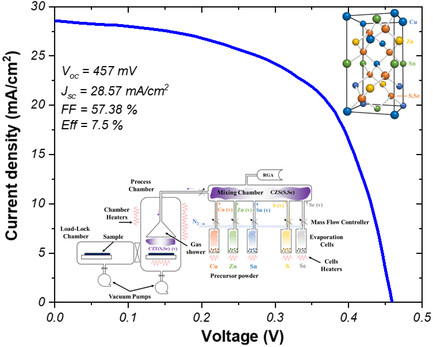
The process called high vapor transport deposition is applied for the first time to deposit kesterite absorber films. The main advantage of this process is the fine tuning capabilities to control the desired stoichiometry in the absorber layer. Additionally, the process allows a high deposition rate and low temperature in the evaporation cells where raw materials are placed.
Noncovalent Conformational Locks Enabling Efficient Nonfullerene Acceptors
- First Published: 16 November 2021
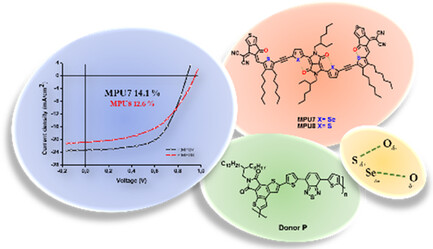
The planarity of two new small-molecule acceptors, based on diketopyrrolopyrrole, is achieved by noncovalent intramolecular interactions. These molecules show broad absorption in the visible and near-infrared region. Binary solar cells built together with a polymer display power conversion efficiency as high as 14.12%.
Numerical Investigation of Interface Passivation Strategies for Sb2Se3/CdS Solar Cells
- First Published: 24 November 2021
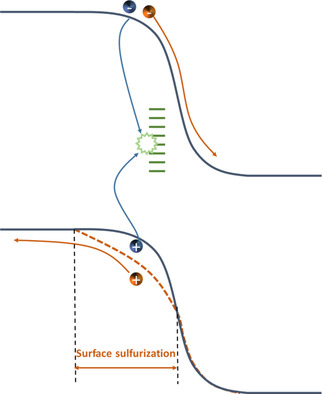
Strategies to mitigate the influence of interfacial recombination in Sb2Se3/CdS solar cells are investigated. The surface sulfurization of the absorber allows to lower the valence band at the vicinity of the pn junction and repels the photoholes from the space charge region, thus quenching interface recombination and significantly improving the power conversion.
Low Temperature Producing Copper-Doped Gallium Oxide as Hole Transport Layers of Perovskite Solar Cells Enhanced by Impurity Levels
- First Published: 16 November 2021
Exploring Inorganic Hole Collection Materials from Mixed-Metal Dawson-Type Polyoxometalates for Efficient Organic Photovoltaic Devices
- First Published: 17 November 2021
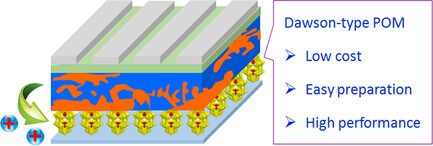
For the first time, it is demonstrated that an organic solar cell (OSC) using the Dawson-type polyoxometalate as hole collection material can exhibit superior photovoltaic efficiency to the device modified by classic interlayer PEDOT:PSS. The results herein suggest that the Dawson-type polyoxometalates can be used as low-cost and effective anode interlayers for the future manufacturing of OSCs.
Vapor-Transport-Deposited Orthorhombic-SnSe Thin Films: A Potential Cost-Effective Absorber Material for Solar-Cell Applications
- First Published: 19 November 2021
Surface-Activated Ti3C2Tx MXene Cocatalyst Assembled with CdZnS-Formed 0D/2D CdZnS/Ti3C2-A40 Schottky Heterojunction for Enhanced Photocatalytic Hydrogen Evolution
- First Published: 23 November 2021
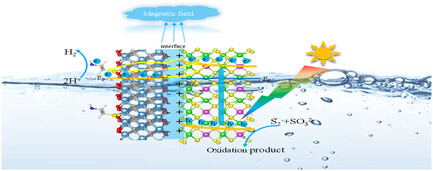
The Ti3C2TX MXene surface activated by diaminoethanethiol molecules has a tuned work function and couples with Cd0.4Zn0.6S to form Schottky junctions. The built-in electric field formed by the surface charge rearrangement is more favorable for the rapid transfer of photogenerated electrons, which makes it exhibit an excellent photocatalytic hydrogen evolution performance.
Mechanism of the Dimethylammonium Cation in Hybrid Perovskites for Enhanced Performance and Stability of Printable Perovskite Solar Cells
- First Published: 23 November 2021
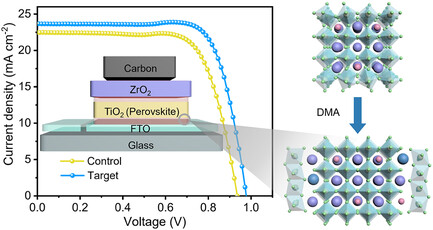
Incorporation of the pseudo-alkali metal cation dimethylammonium into the Cs-stabilized formamidinium lead triiodide perovskite precursor solution for fabricating the printed perovskite solar cells, achieves crystallization control and grain boundary passivation of the perovskite in the mesoscopic scaffold, yielding a device with a power conversion efficiency of 17.46% and long-term operational stability.
Highly Efficient and Industrially Feasible Interdigitated Back-Contact Perovskite Solar Cells with Front Carrier Transport Layers Selected Using 2D Simulation
- First Published: 24 November 2021
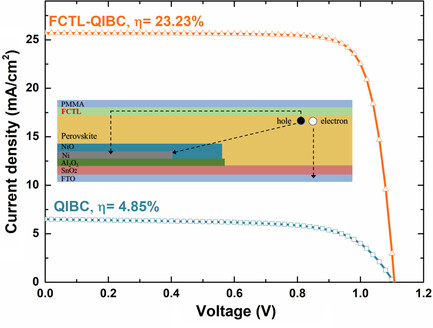
An innovative quasi-interdigitated back-contact (QIBC) perovskite solar cell (PSC) structure featuring a front-carrier transport layer (FCTL) and a broad back-contact pitch is reported. The optimized QIBC-PSC with CuO FCTL demonstrates the best-modeled efficiency of 23.23%, with over 25% efficiency available.
Prediction of Limits of Solar-to-Hydrogen Efficiency from Polarization Curves of the Electrochemical Cells
- First Published: 24 November 2021
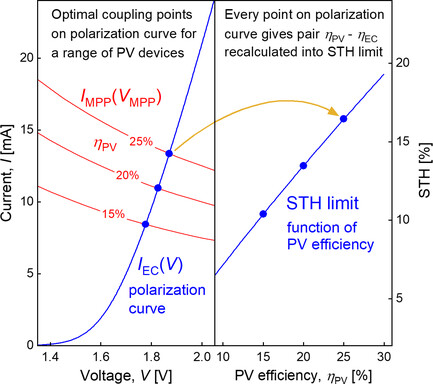
In directly coupled photovoltaic (PV)-assisted water splitting systems, the limit of solar-to-hydrogen efficiency (STH) can be predicted using polarization curves of the electrochemical (EC) cells even without analysis of the PV current–voltage characteristics. The method to find points of optimal coupling between PV and EC, STH limit, and effect of the EC/PV active area ratio are presented.
Predicting Perovskite Bandgap and Solar Cell Performance with Machine Learning
- First Published: 25 November 2021
Realization of a General Method for Extracting Specific Contact Resistance of Silicon-Based Dopant-Free Heterojunctions
- First Published: 26 November 2021

A general method is proposed for extracting the specific contact resistance of a transition metal oxide/a-Si:H(i)/c-Si(n) heterojunction. A deeper theory of ρC extraction is revealed after comprehensive understanding of the transport mechanism at dopant-free heterojunctions (DFHJs). A double (diode + resistance) model is implemented to quickly extract and fit the key parameters of DFHJs.
All-Slot-Die-Coated Inverted Perovskite Solar Cells in Ambient Conditions with Chlorine Additives
- First Published: 29 November 2021

The slot-die coating cycle in ambient conditions is developed for inverted perovskite mini-modules based on MAPbI3 and CsFAPbI3 absorbers. The use of Cl-additives in combination with vacuum quenching is found to be essential for crystallization and uniform morphology of perovskite films and charge transporting layers. Slot-die fabrication was successfully upscaled for mini-modules which demonstrated up to 14.9% of power conversion efficiency.
Crystallinity Modulation of Electron Acceptor in One-Photon Excitation Pathway-Based Heterostructure for Visible-Light Photocatalysis
- First Published: 29 November 2021
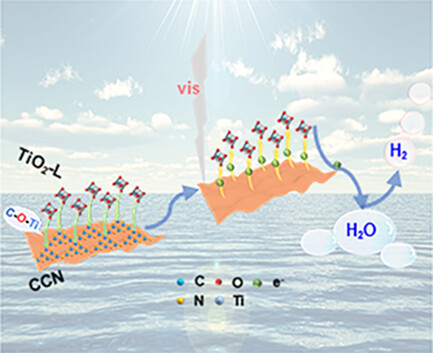
One-photon excitation pathway-based heterostructure design is emerging as an effective approach to promote the visible-light photocatalysis of C3N4. Herein, the counter-intuitive phenomenon is provided that a low crystalline electron acceptor is favorable for constructing a highly efficient interface and thus achieving superior photocatalytic activity under visible light.
Record 1.1 V Open-Circuit Voltage for Cu2ZnGeS4-Based Thin-Film Solar Cells Using Atomic Layer Deposition Zn1-x Sn x O y Buffer Layers
- First Published: 30 November 2021
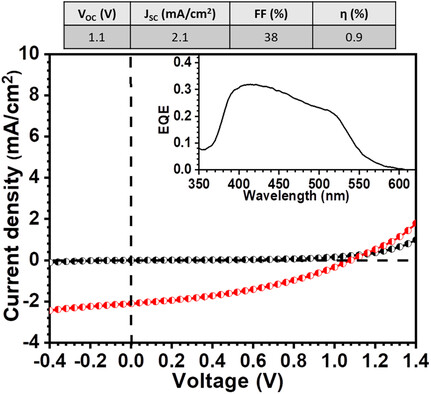
Thin film solar cells based on high bandgap Cu2ZnGeS4 absorbers are fabricated with alternative Zn1– x Sn x O y buffer layers using atomic layer deposition. High open-circuit voltage of up to 1.1 V is obtained, but short-circuit current is limited. Etching of the absorber, with likely removal of germanium oxide influences both current and voltage and large room for further improvements is envisaged.
Highly Reflective and Low Resistive Top Electrode for Organic Solar Cells and Modules by Low Temperature Silver Nanoparticle Ink
- First Published: 30 November 2021
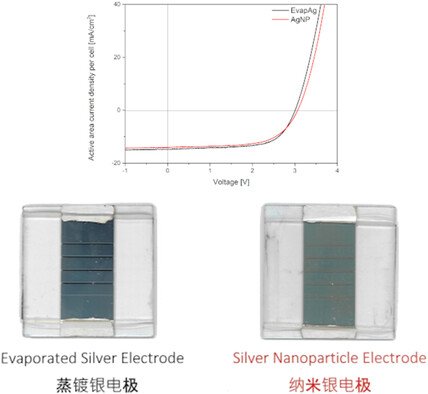
Herein, a scalable and high-performance silver electrode that can serve as a printable replacement to evaporated silver electrodes commonly used in literature is presented. Devices with newly developed electrodes achieve almost the same power conversion efficiencies as evaporated ones. Higher shunt resistances than their vacuum counterparts are also observed and thus perform significantly better under low light conditions.
Solar-Initiated Frontal Polymerization of Photothermic Hydrogels with High Swelling Properties for Efficient Water Evaporation
- First Published: 30 November 2021
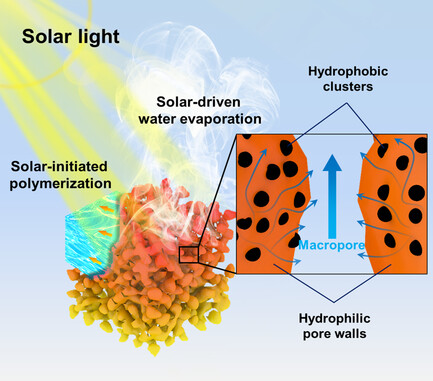
Hierarchical photothermal hydrogel evaporator, prepared by solar-initiated frontal polymerization strategy, featuring broadband optical absorption and high swelling ratio enables enhanced solar water evaporation via low evaporation enthalpy and greatly enlarged evaporation surface area and volume, which provides an alternative opportunity for on-site freshwater production for remote areas/emergency needs.
Serendipitous Doping in Nickel Oxide upon Microwave-Induced Low-Temperature Crystallization Enhances Efficiency of Perovskite Solar Cells
- First Published: 30 November 2021

Microwave irradiation allows a quick low-temperature crystallization of nickel oxide within minutes. Moreover, the doping of In and Sn metal ions diffused from the indium tin oxide layer takes place, leading to unique chemical compositions. The perovskite solar cells with the microwave-annealed nickel oxides show better photovoltaic performances.
Integrated and Unassisted Solar Water-Splitting System by Monolithic Perovskite/Silicon Tandem Solar Cell
- First Published: 02 December 2021
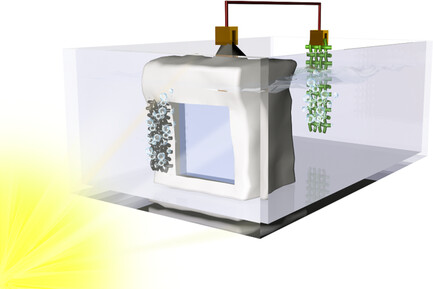
Photoelectrochemical water splitting to hydrogen is a clean process that can achieve green hydrogen. Herein, highly efficient unassisted solar water-splitting devices based on perovskite/silicon tandem solar cells protected by high-transmittance and chemical stability quartz glass are presented, which exhibit a solar–to-hydrogen efficiency of 19.68%.
Efficient and Stable Wide-Bandgap Perovskite Solar Cells Derived from a Thermodynamic Phase-Pure Intermediate
- First Published: 07 December 2021

Herein, a new strategy based on intermediate engineering is reported for the preparation of high-quality, wide-bandgap, mixed-cation lead mixed-halide perovskite FA0.83Cs0.17PbI1.8Br1.2. The phase-pure intermediate is crystallized at a high crystalline level, which facilitates the subsequent crystallization of high-quality perovskite thin films and therefore, results in enhanced device performance.
A Trifluoroethoxyl Functionalized Spiro-Based Hole-Transporting Material for Highly Efficient and Stable Perovskite Solar Cells
- First Published: 07 December 2021
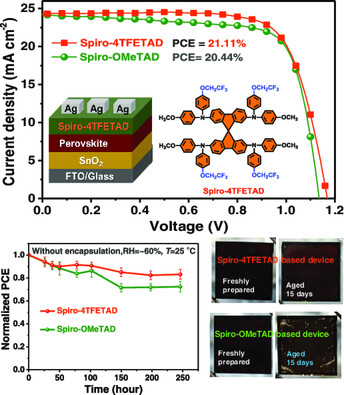
A trifluoroethoxyl functionalized hole transport material, Spiro-4TFETAD, is designed and synthesized. Spiro-4TFETAD shows lower highest occupied molecular orbital level, improved hole mobility, conductivity, and hydrophobicity, as well as effectiveness in minimizing perovskite decomposition, compared to Spiro-OMeTAD. Spiro-4TFETAD-based perovskite solar cells exhibit a power conversion efficiency up to 21.11% with excellent stability, which are superior to those of Spiro-OMeTAD-based devices.
Uninterrupted Self-Generation Thermoelectric Power Device Based on the Radiative Cooling Emitter and Solar Selective Absorber
- First Published: 07 December 2021
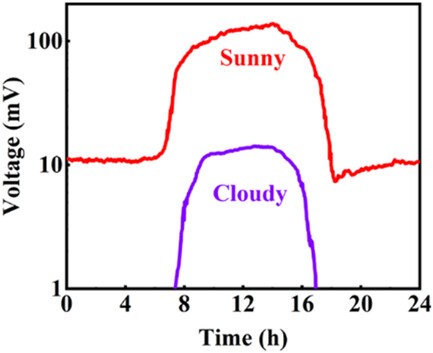
A 24 h uninterrupted self-generation power device based on the radiative cooling emitter and the selective solar absorber (SSA) is fabricated. Maximum output powers of 695.1 mW m−2 in clear daytime and 5.23 mW m−2 in clear nighttime are obtained. The addition of SSA greatly increases the temperature difference and the average work temperature of the device, which brings higher output power.
Fill Factor Assessment in Hole Selective Layer Free Carbon Electrode-Based Perovskite Solar Cells with 15.5% Certified Power Conversion Efficiency
- First Published: 07 December 2021
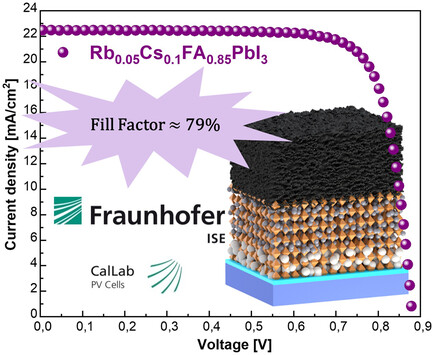
For the first time, a certified fill factor value of 79% is obtained for hole selective layer-free carbon-based perovskite solar devices. The influence of charge recombination and transport losses is assessed. An optimized saturated vapor crystallization in the mesoscopic stack allows for minimized losses, leading to a better interface formation between the perovskite and the adjacent interfaces.
Water-Soluble Organic Dyes as Efficient Anode Interlayer Materials for PEDOT:PSS-Free Inverted Bulk Heterojunction Solar Cells
- First Published: 17 December 2021

Herein, two spirobifluorene-based dyes are deposited from aqueous solutions as efficient anode interlayers (AILs) as a step towards all-solution-processed environmentally friendly organic solar cells. The nonacidic nature of these water-soluble small molecules solves the electrode corrosion issue associated with the commonly employed poly(3,4-ethylenedioxythiophene):poly(styrenesulfonate) (PEDOT:PSS) interlayers while producing higher efficiencies than the photovoltaic devices prepared with PEDOT:PSS AILs.
Co-Hydrothermal Carbonization of Cotton Stalks and MnO2 for Direct Solar Steam Generation with High Efficiency
- First Published: 01 December 2021
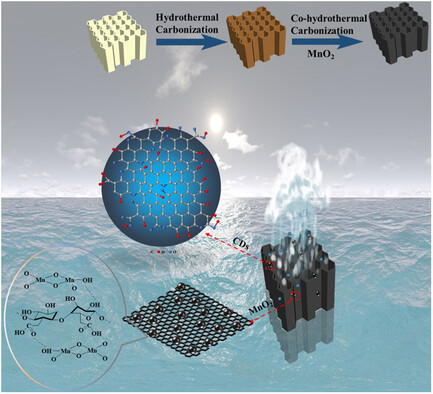
Herein, photothermal materials by cohydrothermal carbonization of cotton stalks and MnO2 are prepared. They have excellent photothermal performance, evaporation efficiency up to 2.43 kg m−2 h−1, with outstanding stability. Carbon dots (CDs) are found through cycling of hydrothermal carbonization fluid. CDs and MnO2 act synergistically to improve the evaporation efficiency of the material up to 2.85 kg m−2 h−1.




